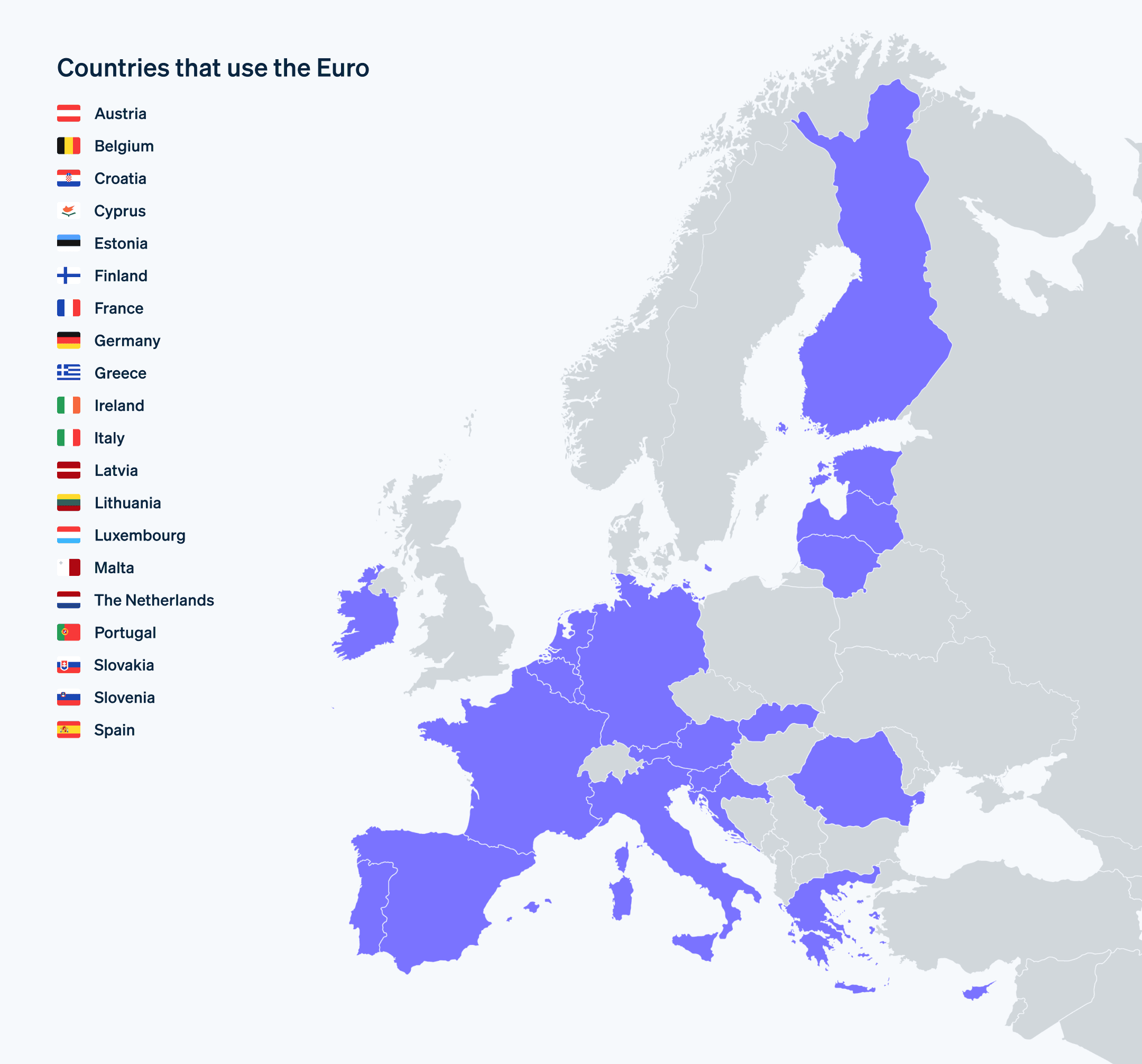Euron är sedan 2022 världens näst mest använda valuta och har ett stort inflytande på den globala ekonomin. Den ger företag och länder ett meningsfullt alternativ till den amerikanska dollarn och främjar konkurrens och stabilitet på valutamarknaderna. Eurons styrka kommer från euroområdet, en samling ekonomiskt kraftfulla nationer som alla använder euron.
Företag inom euroområdet drar nytta av att använda en gemensam valuta. Det gör handeln enklare och tar bort behovet av valutaomvandling. För internationella företag minskas exponeringen för valutakursrisker om man driver sin verksamhet i euro. En stark euro ökar EU:s globala närvaro, vilket gör det möjligt för EU att förespråka sina ekonomiska intressen och bidra till utformningen av globala finansiella regler.
I den här guiden hittar du en sammanfattning över eurons historia och var den för närvarande används.
Vad innehåller den här artikeln?
- Eurons historia
- Eurons betydelse i världsekonomin
- Vilka länder använder euron?
Eurons historia
Euron är den officiella valutan i euroområdet, som omfattar 20 av EU:s 27 medlemsstater. Processen med att skapa en gemensam europeisk valuta började på allvar med Wernerrapporten 1970, som hade målet att skapa en monetär union till 1980, något som inte uppnåddes. I Maastrichtfördraget, som undertecknades 1992, fastställdes formellt kriterierna för införandet av en gemensam valuta. Och 1994 inrättades Europeiska monetära institutet för att stärka samarbetet mellan EU:s centralbanker och för att förbereda för Europeiska centralbanken (ECB) och euron.
Den 1 januari 1999 införde Europeiska unionen euron som en "osynlig" valuta för elektroniska betalningar och bokföringsändamål, samtidigt som man fortsatte att använda nationella valutor för kontanttransaktioner. Eurosedlar och euromynt sattes i omlopp den 1 januari 2002 och ersatte de gamla valutorna i 12 medlemsstater och markerade den största kontantövergången i historien. De gamla nationella valutorna upphörde kort därefter att vara lagliga betalningsmedel.
Den globala finanskrisen 2008 och efterföljande europeiska skuldkriser avslöjade dock svagheter i euroområdets ekonomiska struktur. EU införde åtgärder såsom Europeiska stabilitetsmekanismen (ESM) för att skapa finansiell stabilitet och stöd till medlemsländer med finansiella svårigheter.
Euroområdet utvidgades under åren som följde i takt med att de nya EU-medlemmarna uppfyllde de ekonomiska Maastrichtkriterierna för medlemskap: Slovenien anslöt sig 2007, Malta 2008, Slovakien 2009, Estland 2011, Lettland 2014 och Litauen 2015. Kroatien är det senaste tillskottet och införde euron 2023.
Eurons betydelse i världsekonomin
Underlättar handel: Euron förenklar handeln mellan medlemsländerna i euroområdet och med resten av världen. Genom att eliminera risker och kostnader för valutaväxling skapar euron en mer transparent prissättning och minskar transaktionskostnaderna.
Främjar ekonomisk integration: Införandet av euron har lett till en mer synkroniserad ekonomisk politik och reglering mellan medlemsstaterna. Denna integration har skapat en stabilare och mer förutsägbar ekonomisk miljö i Europa, vilket är gynnsamt för affärsplanering och investeringar.
Fungerar som en global reservvaluta: Euron är en av de viktigaste reservvalutorna i världen och innehas av flera centralbanker och finansinstitut som en del av deras valutareserver. Detta ger euron inflytande över de globala växelkurserna och penningpolitiken.
Påverkar globala marknader: Euroområdets penningpolitik, som styrs av ECB, har stor inverkan på de globala finansmarknaderna. Beslut om räntor eller kvantitativa lättnader i euroområdet kan påverka globala kapitalflöden, investeringsbeslut och ekonomiska förhållanden utanför Europa.
Främjar EU-samarbete: Euron är en symbol för europeisk enhet och identitet, och för att förvalta den krävs ett nära samarbete mellan medlemsländerna. Detta nödvändiga samarbete främjar regional politisk integration och stabilitet i regionen, vilket är särskilt viktigt i tider av ekonomisk eller politisk turbulens.
Skapar attraktiva investeringsmöjligheter: Euroområdet är en stor och attraktiv marknad för investeringar. Euron erbjuder investerarna de fördelar som en stor integrerad marknad ger och som undviker de risker som är förknippade med valutafluktuationer, som annars skulle kunna finnas mellan mindre, separata nationella marknader.
Vilka länder använder euron?
I maj 2024 var euron den officiella valutan i 20 europeiska länder med cirka 341 miljoner användare varje dag. Dessa länder bildar tillsammans det som kallas euroområdet:
Österrike, Belgien, Kroatien, Cypern, Estland, Finland, Frankrike, Tyskland, Grekland, Irland, Italien, Lettland, Litauen, Luxemburg, Malta, Nederländerna, Portugal, Slovakien, Slovenien och Spanien.

Trots att de inte tillhör EU använder mikrostater och stadsstater i Europa också euron på grund av deras närhet till länderna i euroområdet. Euron används också av länder som har ansökt om EU-medlemskap men ännu inte är medlemmar. Dessa områden inkluderar:
Andorra: Andorra införde euron 2002 och gjorde den till landets officiella valuta 2011.
Kosovo: Kosovo antog euron som sin officiella valuta 2002.
Monaco: Monaco införde euron som sin officiella valuta 2002.
Montenegro: Montenegro införde euron som sin officiella valuta 2002.
San Marino: San Marino införde euron som sin officiella valuta 2002.
Vatikanstaten: Vatikanstaten antog euron som sin officiella valuta 2002.
På dessa platser underlättar euron ekonomiska transaktioner och stöder den lokala ekonomin genom att knyta den till en stark och stabil valuta.
Innehållet i den här artikeln är endast avsett för allmän information och utbildningsändamål och ska inte tolkas som juridisk eller skatterelaterad rådgivning. Stripe garanterar inte att informationen i artikeln är korrekt, fullständig, adekvat eller aktuell. Du bör söka råd från en kompetent advokat eller revisor som är licensierad att praktisera i din jurisdiktion för råd om din specifika situation.